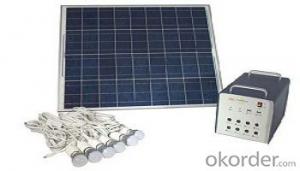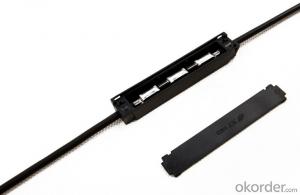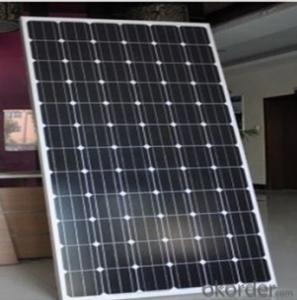Household Solar Power Kit Hot Selling SPK_P1000
- Loading Port:
- China main port
- Payment Terms:
- TT OR LC
- Min Order Qty:
- 3 pc
- Supply Capability:
- 10000 pc/month
OKorder Service Pledge
OKorder Financial Service
You Might Also Like
Main Information
KDF SPK_P1000 This product is high performance,family used portable solar power system,which can receive energy and store it in battery outside connected to SPK by solar energy on sunny day,and supplies electric power for varies appliances such as electric fan,lighting lamps, television, portable computer etc.It can supply power for both DC and AC electric application .It’s very helpful and useful for home electric supply.
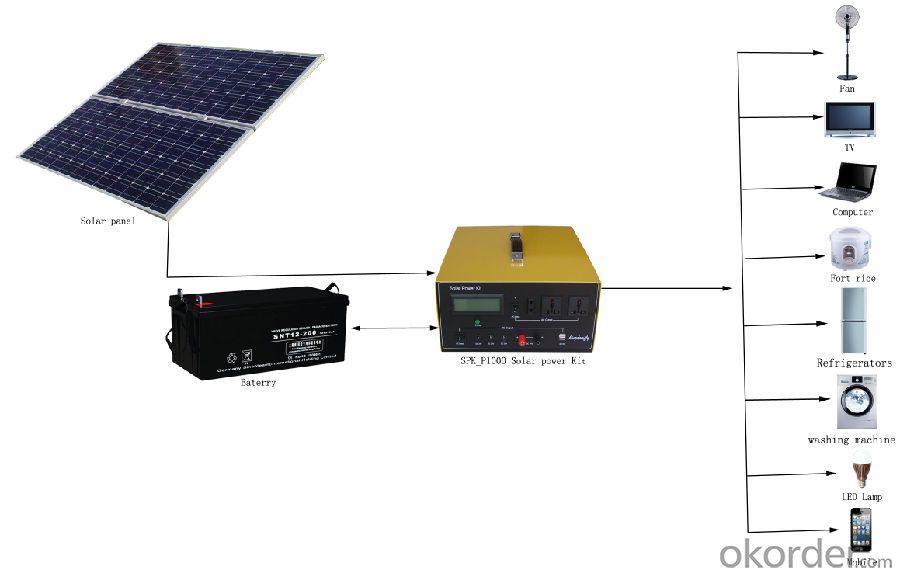
Features:
◆ Battery puts outside connected to the SPK for user to choose battery in recommended range, and easily to exchange battery.
◆ Both DC and AC output
◆ Solar Feedback Circuit Protection
◆ Output Short-circuit Protection
◆ Solar「+」「-」anti-access protection
◆ Output「+」「-」anti-access protection
◆ Over Charged Protection
◆ Over Discharged Protection
◆ Over Load Protection
◆ Over-Temperature Protection
Technical parameters
Specification | Value/Material | |
Item No. KDF | SPK_P1000 | |
Solar Recommended | Specification | Poly silicon |
Working Voltage/Power | 36V/80W~500W | |
Battery Recommended | Rated Voltage/Capacity | 24V50AH~200AH |
Cycle Number | 80% Deep Cycle Number:500 70% Cycle Number:800 | |
Working Temperature | Short Period(one Month):-20~50℃Long Period(Six Months):-10~45℃ | |
Charging Controller | Operating Voltage | 24V |
Input Voltage | 34.6V~42V | |
Input current | MAX:20A | |
Power Consumption | MAX: 15mA | |
Low Voltage Disconnect(LVD) | 21.6V | |
Low Voltage Reconnect(LVR) | 24.6V | |
High Voltage Discharge( HVC) | 29.2V | |
High Voltage Recharge(HVR) | 27.6V | |
Temperature Protection | 60℃ | |
DC Output | DC output & Application | USB 5V2A |
DC output & Application | DC 24V | |
AC Output | Output Wave | Pure sine wave |
Input Voltage | 22V~30V | |
Output Voltage | 220V±10% | |
Output Frequency | 60Hz±2Hz/50Hz±2Hz | |
Rated Output Power | 1000W | |
Maximum VA | 2000VA | |
Maximum Efficiency | 88% | |
Temperature | 0-40℃ | |
Over Temperature | 60℃~70℃ | |
Low Voltage Alarm | 22V | |
Low Voltage Shut off | 21V | |
High Voltage Shut off | 30V | |
Package | Set size | 350*449*227mm |
Set N·W | 7.2kg | |
Set N·W | 5.2kg | |
LCD_Display
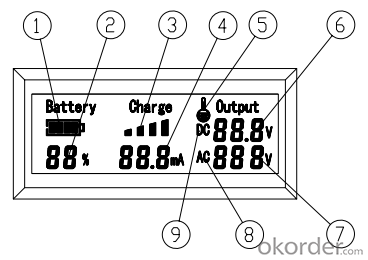
No. | Name | Function |
1 | Battery Icon | To show the Volume of the Battery |
2 | Date of % | To show the percent of the Battery |
3 | Charging Icon | To show the charging condition |
4 | Current | To show the value of charge current |
5 | Temperature Icon | Temperature Alarm |
6 | Date of Voltage | To Show the Value of DC output voltage |
7 | Date of Voltage | To Show the Value of AC output voltage |
8 | AC Icon | AC output |
9 | DC Icon | DC output |
- Q:Can solar energy systems be used for powering electric vehicle solar charging parking lots?
- Solar energy systems are certainly capable of powering electric vehicle solar charging parking lots. The combination of solar energy and electric vehicle charging is becoming increasingly popular as a sustainable solution for transportation and energy requirements. Sunlight can be captured and converted into electricity by installing solar panels on the parking lot structure or nearby rooftops. This clean energy can then be used to power the electric vehicle charging stations located within the parking lot. By utilizing solar power, these charging stations can operate independently of the grid, reducing the reliance on fossil fuels and minimizing greenhouse gas emissions. Furthermore, solar-powered charging lots have the advantage of generating electricity during the day when the demand for charging is typically higher. This merging of solar energy systems and electric vehicle charging infrastructure is an innovative and environmentally friendly approach to powering transportation.
- Q:Can solar energy systems be integrated into building design?
- Yes, solar energy systems can be integrated into building design. In fact, integrating solar energy systems into building design is becoming increasingly common and is considered a sustainable and cost-effective approach to generating electricity. There are various ways to incorporate solar energy systems into building design, including rooftop solar panels, solar facades, and solar windows. Rooftop solar panels are the most commonly used method of integrating solar energy systems into building design. They can be installed on the roofs of buildings, either as standalone structures or integrated into the roof itself. These panels capture sunlight and convert it into electricity, which can be used to power the building or be fed back into the grid. Solar facades are another way to integrate solar energy systems into building design. These systems involve installing solar panels on the outer walls of buildings. They not only generate electricity but also act as a protective layer, reducing heat gain and improving the building's energy efficiency. Solar windows are a relatively new development in building-integrated solar energy systems. These windows are designed with built-in transparent solar cells that can capture sunlight and generate electricity while still allowing natural light to enter the building. Solar windows have the potential to revolutionize building design by seamlessly integrating renewable energy generation into the building envelope. Integrating solar energy systems into building design offers several advantages. First and foremost, it allows buildings to generate their own electricity, reducing reliance on fossil fuel-based power sources and lowering utility bills. Additionally, it contributes to the reduction of greenhouse gas emissions, promoting a cleaner and more sustainable environment. Moreover, solar energy systems can enhance the aesthetic appeal of buildings, turning them into visually striking examples of sustainable architecture. In conclusion, solar energy systems can indeed be integrated into building design. With various options available, including rooftop solar panels, solar facades, and solar windows, buildings can generate their own clean, renewable electricity, reduce their carbon footprint, and contribute to a more sustainable future.
- Q:What is the impact of dust and dirt on the performance of solar panels?
- The performance of solar panels is significantly affected by dust and dirt. When dust settles on the panel surface, it forms a layer that blocks sunlight from reaching the photovoltaic cells. This causes a decrease in light absorption and overall energy output. Over time, the accumulation of dust can greatly reduce efficiency and impact the system's performance. Additionally, dirt and dust can create shading on the panels, resulting in hotspots. These hotspots can cause localized heating, potentially damaging the panel's electronics and reducing their lifespan. The increased temperatures also lead to decreased efficiency and further decrease energy production. To mitigate the impact of dust and dirt, regular cleaning and maintenance of solar panels are crucial. This can be done manually through periodic washing or by installing automated cleaning systems to keep the panels free from debris. By ensuring clean panels, the amount of sunlight reaching the photovoltaic cells is maximized, optimizing energy production and promoting the longevity of the solar panel system.
- Q:How much space is needed for installing solar panels?
- The space needed for installing solar panels depends on various factors, such as the size and number of panels, their efficiency, and the energy requirements of the property. On average, a typical residential solar panel system requires around 100-400 square feet of unshaded roof space per kilowatt of installed capacity. However, ground-mounted systems can be installed if there is enough available space. It is recommended to consult with a solar installation professional to determine the specific space requirements based on individual circumstances.
- Q:How do solar energy systems affect property values?
- Solar energy systems can have a positive impact on property values as they are considered desirable features by many homebuyers. Studies have shown that homes equipped with solar panels tend to sell faster and at higher prices compared to similar properties without solar systems. The potential for reduced energy costs, environmental benefits, and increased energy independence make solar energy systems an attractive investment, ultimately boosting property values.
- Q:Can solar energy systems be used for powering schools or educational institutions?
- Schools and educational institutions can utilize solar energy systems to provide power. In fact, many schools around the world are adopting solar energy systems as a sustainable and clean energy source. Solar panels can be installed on school buildings or in open spaces on campus to harness the sun's power. This renewable energy source can generate a significant amount of electricity for the school. There are several advantages to incorporating solar energy systems in schools. Firstly, solar power is a clean energy source that does not produce harmful emissions or contribute to air pollution. This helps reduce the carbon footprint of the school. Additionally, solar energy systems can save schools money on their electricity bills in the long term. Once the initial installation costs are recovered, the electricity generated by solar panels is essentially free. These savings can be reinvested in educational resources or programs. Integrating solar energy systems into schools also provides valuable educational opportunities for students. By utilizing solar power, schools can educate students about renewable energy, climate change, and the importance of sustainability. Students can learn about the science behind solar energy, the benefits of clean energy sources, and their role in promoting a greener future. Furthermore, solar energy systems can serve as a backup power source during outages or emergencies. This ensures uninterrupted power supply to the school, especially during critical times like exams or in areas with unreliable electricity infrastructure. In conclusion, solar energy systems can be effectively used to power schools and educational institutions. They offer numerous benefits, including reduced carbon emissions, cost savings, educational opportunities, and backup power capabilities. By embracing solar power, schools can demonstrate their commitment to sustainability, inspire students, and contribute to a cleaner and greener future.
- Q:How much sunlight is needed for a solar energy system to be effective?
- A solar energy system can be effective with as little as 4-5 hours of direct sunlight per day, although more sunlight will generally result in higher energy production.
- Q:Can solar energy systems be used in military applications?
- Indeed, solar energy systems have the capability to be utilized in military applications. The adaptability and reliability of solar technology have been proven, rendering it an appealing choice for military operations. The military has acknowledged the advantages of solar energy systems in terms of lessening reliance on fossil fuels and heightening energy security in remote or unstable regions. The portability of solar energy systems in military applications is one of their primary benefits. Solar panels and related equipment can be effortlessly transported and deployed in various locations, supplying power for small-scale operations or even entire bases. This flexibility enables military units to function in off-grid or challenging environments where conventional energy sources may be scarce or undependable. Furthermore, solar energy systems can improve the sustainability and resilience of military operations. By generating renewable energy on-site, the military can decrease its carbon footprint and reduce dependence on vulnerable supply chains for fuel. Solar power can be combined with energy storage solutions to ensure uninterrupted power supply, even during grid failures or combat situations. Moreover, solar energy systems contribute to long-term cost savings. Although the initial investment may be greater compared to conventional energy sources, solar technology has become increasingly affordable. Over time, the operational and maintenance expenses of solar systems are significantly lower than those of conventional energy sources. This can lead to substantial savings for the military, permitting resources to be allocated to other critical areas. In addition to these benefits, solar energy systems also offer enhanced tactical advantages. Solar-powered equipment and devices can operate silently, minimizing the risk of detection by enemy forces. Furthermore, solar energy systems can reduce the logistical burden of transporting and storing traditional energy sources, enabling military units to be more agile and efficient in their operations. Overall, solar energy systems provide numerous advantages for military applications. The versatility, portability, sustainability, cost-effectiveness, and tactical benefits of the technology make it a valuable asset in enhancing military capabilities while reducing environmental impact and bolstering energy security.
- Q:Can solar panels be used to charge mobile devices?
- Yes, solar panels can be used to charge mobile devices.
- Q:Can a solar energy system be used to power agricultural operations?
- Yes, a solar energy system can be used to power agricultural operations. Solar energy systems, such as solar panels, can generate electricity by converting sunlight into usable energy. This electricity can be utilized to power various agricultural operations, such as irrigation systems, water pumps, machinery, and lighting. Solar-powered irrigation systems are particularly beneficial for agricultural operations as they can provide a reliable and sustainable source of energy for watering crops. These systems can be designed to automatically turn on and off based on sunlight availability, ensuring that crops receive the necessary amount of water. Solar-powered water pumps can also be used to extract water from wells or other water sources, reducing the reliance on fossil fuels and minimizing operational costs. Additionally, solar energy can be used to power machinery and equipment used in agricultural operations. This includes tractors, harvesters, and other farm equipment, reducing the dependency on fossil fuels and lowering carbon emissions. Solar-powered lighting can also be installed in agricultural facilities, such as barns or storage areas, providing illumination without the need for grid electricity. In regions with abundant sunlight, solar energy systems can be a cost-effective and sustainable solution for powering agricultural operations. They offer numerous benefits, including reduced operational costs, decreased carbon footprint, and increased energy independence.
1. Manufacturer Overview |
|
|---|---|
| Location | |
| Year Established | |
| Annual Output Value | |
| Main Markets | |
| Company Certifications | |
2. Manufacturer Certificates |
|
|---|---|
| a) Certification Name | |
| Range | |
| Reference | |
| Validity Period | |
3. Manufacturer Capability |
|
|---|---|
| a)Trade Capacity | |
| Nearest Port | |
| Export Percentage | |
| No.of Employees in Trade Department | |
| Language Spoken: | |
| b)Factory Information | |
| Factory Size: | |
| No. of Production Lines | |
| Contract Manufacturing | |
| Product Price Range | |
Send your message to us
Household Solar Power Kit Hot Selling SPK_P1000
- Loading Port:
- China main port
- Payment Terms:
- TT OR LC
- Min Order Qty:
- 3 pc
- Supply Capability:
- 10000 pc/month
OKorder Service Pledge
OKorder Financial Service
Similar products
New products
Hot products
Hot Searches
Related keywords








